West Bank 7 December 2004
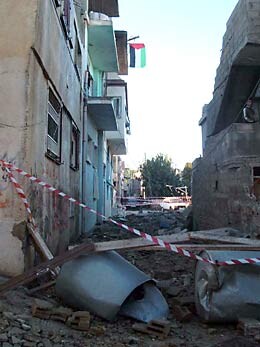
A few weeks after Jacob visited Ibdaa Cultural Center, Israel demolished parts of the building in which the kindergarten was housed. The building contained a total of eight apartments. The first two floors were rented by Ibdaa, for its kindergarten. One hundred and twenty children, aged 3-6 years old, have learned, played, danced, sung and been safe within those walls for the past 4 years. (Ziad Abbas)
I was sitting in a room on the bottom floor of the Ibdaa Cultural Center in Dheisheh Refugee Camp near Bethlehem. With me was a delegation from Berkeley Jews for Palestine (a group of anti-Zionist Jewish Americans), the Director of Ibdaa and a group of youth from the Center. Ibdaa is a cultural center for the youth of Dheisheh Camp.
Al-Nakba
The residents of Dheisheh are from 46 villages which were depopulated by Zionist forces in 1948. There were over 418 villages cleansed of their Palestinian inhabitants in 1948 as nearly 800,000 Palestinians were forced to flee their homes in what is now the state of Israel. Israelis mark the event as their independence day, but for Palestinians it is Al-Nakba (“The Catastrophe”). Today, there are over 5 million Palestinian refugees spread around the world. Many live in refugee camps in the West Bank, Gaza Strip, Lebanon, Jordan and Syria.
Al-Nakba stands as the defining moment in the Palestinian narrative. No other event captures the pain of Palestinians so wholly and unites them so closely. The goal of Ibdaa’s Oral History Program is to tell the stories of Al-Nakba and of life in the depopulated villages. The program once included taking groups of children from Dheisheh for visits to their home villages inside what is now Israel. Since the renewed Israeli crackdown on Palestinian movement in 2000, however, the Israeli government has refused to allow the trips and has denied travel permits to the children of Dheisheh. Many of the kids have never seen their home village, although most are less than 20 miles from the camp.
The young girl continued to tell us about her village. She explained that many of the homes there had been occupied by Israelis. Other homes had been demolished. In fact, many of the depopulated Palestinian villages were totally destroyed soon after the war when the state of Israel was created. The new Israeli government quickly passed a series of laws to appropriate the vacated Palestinian land and define the refugees as “infiltrators” that were to be banned from the country. In the meantime, the United Nations Security Council passed Resolution 194, affirming the right of the 1948 refugees to return to their homes. A right that has yet to be honored.
In Dheisheh, as in other Palestinian refugee camps in the West Bank and Gaza Strip, life is as unstable as the conflict itself. The refugees have tried to make the camp as comfortable as possible, erecting cement houses and small gardens where once there were only tents. Many have the deeds to their land inside Israel and the keys to the homes which stood there. Consecutive Israeli governments, however, have refused to honor the Right of Return of the Palestinians who lost their homes in 1948. Meanwhile, the more than 5 million refugees wait for their rights to be addressed.
‘Anata
A day after my visit to Ibdaa, I found myself in the village of ‘Anata in East Jerusalem watching an Israeli bulldozer tear down the home of a Palestinian family. There were two Palestinian homes demolished on Monday (November 29) and another destroyed the following day. I received a call on Monday morning and within the hour a coworker and I were negotiating our way through the Israeli checkpoints between Bethlehem and ‘Anata. We followed the Wall winding through Palestinian land east of Jerusalem and ended up on a hilltop overlooking a small valley and the ruins of several house demolitions lingering on the hillside.
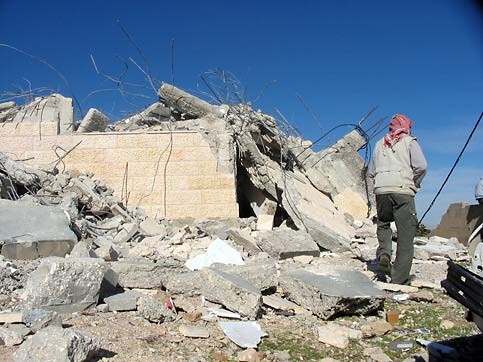
The ruins of the home of the Qaboah family. The home was demolished by Israeli occupying forces on the morning of Monday, November 29, 2004 in ‘Anata, Occupied East Jerusalem. (Jacob Pace)
The first house was already a pile of rubble when we arrived. The house belonged to the Qaboah family. Jadoah Qaboah had worked for 30 years to raise the money for the two story structure that housed 23 people. Most of the Qaboah family was lingering around the remains of their home. Their furniture sat on the dirt nearby. About 20 Israeli Border Police were spread around the top of the hill, standing with automatic assault rifles slung over their shoulder.
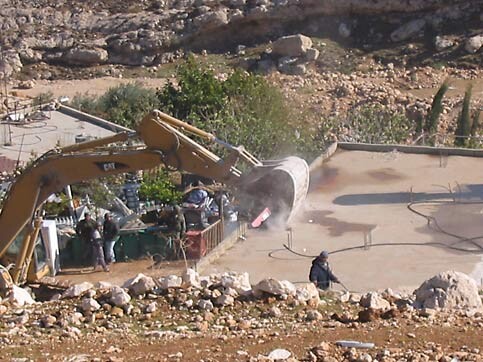
An Israeli Caterpillar Backhoe tears into the home of the Dandees family. The home housed 13 people and was demolished by Israeli occupying forces on the afternoon of Monday, November 29, 2004 in ‘Anata, Occupied East Jerusalem. (Jacob Pace)
We walked across the rubble of the first house to look down upon another house and another group of Border Police watching a Palestinian family remove the last of their belongings. A Caterpillar backhoe moved towards the house. The owner of the house stepped out in front of the backhoe in a final act of defiance. The machine stopped for a moment but the Border Police grabbed the man and forced him to the side. The backhoe moved forward, raised its bucket and slammed the jagged points into the roof of the house. As we watched, it continued to claw at the house, ripping apart the cement walls and rebar supports. It only took about 10 minutes for the entire house to be reduced to a pile of rubble. Meanwhile, the family could only watch.
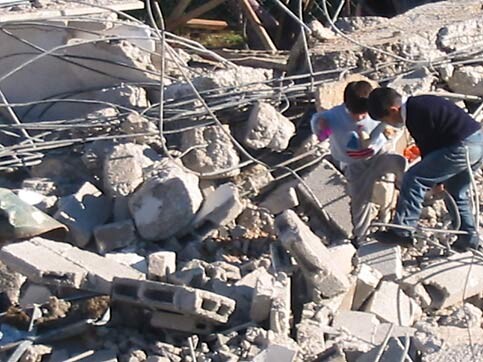
Children from the Dandees family climb across the ruins of their home which was demolished by Israeli occupying forces on the afternoon of Monday, November 29, 2004 in ‘Anata, Occupied East Jerusalem. (Jacob Pace)
The home belonged to the Dandees family. It housed 13 people who are now left homeless. Both the Qaboa and the Dandees families held title to the lands and are in possession of the original title deeds (Tabu) dating back to the period of Ottoman rule in the 19th Century. Both families had applied repeatedly for building permits from the Israeli occupation authorities. The requests were always denied. In fact, Palestinian families in occupied East Jerusalem are hardly ever granted building permits. It is one method Israel uses to limit the Palestinian population of the city. If people cannot build homes on their land they have two choices: either leave the land or build illegally. When they build illegally, however, Palestinian families risk having their homes demolished by Israel. The Qaboa and Dandees families are the latest victims of this policy. They received demolition orders on November 26, giving them three days to destroy the home themselves or it would be demolished by Israel. The bulldozers arrived promptly three days later.
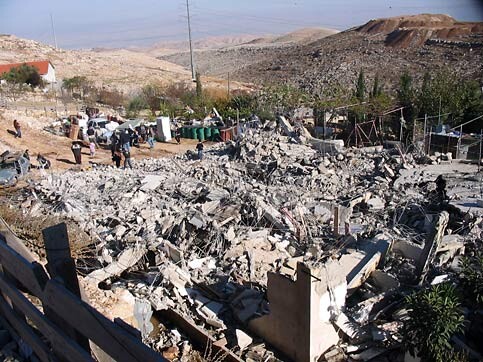
The ruins of the Dandees family home after it was demolished by Israeli occupying forces on the afternoon of Monday, November 29, 2004 in ‘Anata, Occupied East Jerusalem. (Jacob Pace)
The case of ‘Anata is illustrative in more ways than one. Like other East Jerusalem communities, ‘Anata has been the victim of aggressive Israeli colonization schemes. In fact, over 90% of the village lands have been illegally appropriated by Israel. Four illegal Israeli settlements have been built around ‘Anata and Israeli bypass roads hem it in on three sides. More recently, an Israeli military prison has been built on ‘Anata land and Israeli occupying forces have served residents of the village with land seizure documents for the purpose of building the Apartheid Wall. Land clearing operations have already begun to set the groundwork for construction of the Wall. The projected path will cut around the illegal Israeli settlements, surrounding ‘Anata on three sides and turning it into a tiny ethnic Palestinian ghetto.
The homes demolished on Monday were very close to the projected path of the Wall. The Dandees home was only 100 meters (approximately 300 ft.) from the Wall cutting across village lands south of the built-up area. The new military prison is on the hill opposite the homes and there are plans to build a new Israeli by-pass road in the valley between. Israeli bulldozers are also busy on the ridge in front of the prison. A new development project is underway either to expand the prison or construct a new illegal settlement there.
There is so much more that can be said about the colonization of Palestinian land, the ghettoization of ‘Anata, and Israel’s brutal home demolition policy. Pages of information have been scripted and distributed by Palestinian and Israeli NGO’s (The Israeli Coalition Against Home Demolitions has been especially active in ‘Anata, rebuilding one home a total of 4 times). The facts are available for anyone to access.
But it was the rapid transition between my experience at the Ibdaa Cultural Center in Dheisheh on Sunday, and the home demolitions in ‘Anata on Monday that gave me cause for further reflection. The refugee children of Dheisheh spoke of the loss of their homes. Homes their families had been expelled from in Al Nakba. And in ‘Anata, I witnessed more expulsions. 56 years later, the story is startlingly similar. Israeli soldiers came to expel two more Palestinian families from their homes. Two more families were uprooted and made refugees in their own land. The experience of being uprooted is something most of us have never had to experience. But it is a reality for many Palestinian families struggling under Israeli occupation.
Related Links
Jacob Pace lives in Beit Sahour and works with the Applied Research Institute- Jerusalem (ARIJ) in Bethlehem. His reports and photos are available online at www.rcnv.org/gaza. For more information on the home demolitions in ‘Anata, see the upcoming case study on the ARIJ website: www.arij.org.



